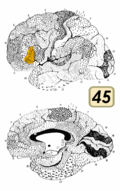Broca's area
| Broca's area | |
|---|---|
 Broca's area is made up of Brodmann areas 44 (pars opercularis) and 45 (pars triangularis). | |
 Broca's area (shown in red) | |
| Details | |
| Part of | Frontal lobe |
| Artery | Middle cerebral |
| Vein | Superior sagittal sinus |
| Identifiers | |
| MeSH | D065711 |
| NeuroNames | 2062 |
| FMA | 242176 |
| Anatomical terms of neuroanatomy | |
Broca's area, or the Broca area (/ˈbroʊkə/,[1][2][3] also UK: /ˈbrɒkə/, US: /ˈbroʊkɑː/[4]), is a region in the frontal lobe of the dominant hemisphere, usually the left, of the brain[5] with functions linked to speech production.
Functional magnetic resonance imaging (fMRI) has shown language processing to also involve the third part of the inferior frontal gyrus the pars orbitalis, as well as the ventral part of BA6 and these are now often included in a larger area called Broca's region.[8]
Studies of chronic aphasia have implicated an essential role of Broca's area in various speech and language functions. Further, fMRI studies have also identified activation patterns in Broca's area associated with various language tasks. However, slow destruction of Broca's area by brain tumors can leave speech relatively intact, suggesting its functions can shift to nearby areas in the brain.[9]
Structure


Broca's area is often identified by visual inspection of the topography of the brain either by macrostructural landmarks such as sulci or by the specification of coordinates in a particular reference space. The currently used Talairach and Tournoux atlas projects Brodmann's cytoarchitectonic map onto a template brain. Because Brodmann's parcelation was based on subjective visual inspection of cytoarchitectonic borders and also Brodmann analyzed only one hemisphere of one brain, the result is imprecise. Further, because of considerable variability across brains in terms of shape, size, and position relative to sulcal and gyral structure, a resulting localization precision is limited.[10]
Nevertheless, Broca's area in the left hemisphere and its homologue in the right
Area 45 receives more
The differences between area 45 and 44 in cytoarchitecture and in connectivity suggest that these areas might perform different functions. Indeed, recent neuroimaging studies have shown that the PTr and Pop, corresponding to areas 45 and 44, respectively, play different functional roles in the human with respect to language comprehension and action recognition/understanding.[11]
The Broca's area is about 20% larger in women than in men.[12]
Functions
Language comprehension
For a long time, it was assumed that the role of Broca's area was more devoted to language production than language comprehension. However, there is evidence to demonstrate that Broca's area also plays a significant role in language comprehension. Patients with
There is also specialisation for particular aspects of comprehension within Broca's area. Work by Devlin et al. (2003)
- Semantic tasks only showed a decrease in reaction times when stimulation was aimed at the anterior part of Broca's area (where a decrease of 10% (50 ms) was seen compared to a no-TMS control group)
- Phonologicaltasks showed a decrease in reaction times when stimulation was aimed at the posterior part of Broca's area (where a decrease of 6% (30 ms) was seen compared to control)
To summarise, the work above shows anatomical specialisation in Broca's area for language comprehension, with the anterior part of Broca's area responsible for understanding the meaning of words (semantics) and the posterior part of Broca's area responsible for understanding how words sound (phonology).
Action recognition and production
Experiments have indicated that Broca's area is involved in various cognitive and perceptual tasks. One important contribution of Brodmann's area 44 is also found in the motor-related processes. Observation of meaningful hand shadows resembling moving animals activates frontal language area, demonstrating that Broca's area indeed plays a role in interpreting action of others.[19] An activation of BA 44 was also reported during execution of grasping and manipulation.[20]
Speech-associated gestures
It has been speculated that because speech-associated gestures could possibly reduce lexical or sentential ambiguity, comprehension should improve in the presence of speech-associated gestures. As a result of improved comprehension, the involvement of Broca's area should be reduced.[11]
Many neuroimaging studies have also shown activation of Broca's area when representing meaningful arm gestures. A recent study has shown evidence that word and gesture are related at the level of translation of particular gesture aspects such as its motor goal and intention.[21] This finding helps explain why, when this area is defective, those who use sign language also have language deficits.[22]: 494–7 This finding, that aspects of gestures are translated in words within Broca's area, also explains language development in terms of evolution. Indeed, many authors have proposed that speech evolved from a primitive communication that arose from gestures.[19][23] (See below.)
Speaking without Broca's area
Damage to Broca's area is commonly associated with telegraphic speech made up of content vocabulary. For example, a person with Broca's aphasia may say something like, "Drive, store. Mom." meaning to say, "My mom drove me to the store today." Therefore, the content of the information is correct, but the grammar and fluidity of the sentence is missing.[24]
The essential role of the Broca's area in speech production has been questioned since it can be destroyed while leaving language nearly intact. In one case of a computer engineer, a slow-growing
Clinical significance
Stuttering
A speech disorder known as stuttering is seen to be associated with underactivity in Broca's area.[25][26]
Aphasia
Aphasia is an acquired language disorder affecting all modalities such as writing, reading, speaking, and listening and results from brain damage. It is often a chronic condition that creates changes in all areas of one's life.[27]
Expressive aphasia vs. other aphasias
Patients with
This specific group of symptoms distinguishes those who have expressive aphasia from individuals with other types of aphasia. There are several distinct "types" of aphasia, and each type is characterized by a different set of language deficits. Although those who have expressive aphasia tend to retain good spoken language comprehension, other types of aphasia can render patients completely unable to understand any language at all, unable to understand any spoken language (
In the classical sense, expressive aphasia is the result of injury to Broca's area; it is often the case that lesions in specific brain areas cause specific, dissociable symptoms,[31] although case studies show there is not always a one-to-one mapping between lesion location and aphasic symptoms.[29] The correlation between damage to certain specific brain areas (usually in the left hemisphere) and the development of specific types of aphasia makes it possible to deduce (albeit very roughly) the location of a suspected brain lesion based only on the presence (and severity) of a certain type of aphasia, though this is complicated by the possibility that a patient may have damage to a number of brain areas and may exhibit symptoms of more than one type of aphasia. The examination of lesion data in order to deduce which brain areas are essential in the normal functioning of certain aspects of cognition is called the deficit-lesion method; this method is especially important in the branch of neuroscience known as aphasiology. Cognitive science – to be specific, cognitive neuropsychology – are branches of neuroscience that also make extensive use of the deficit-lesion method.[32]
| Type of aphasia | Speech repetition | Naming | Auditory comprehension | Fluency |
|---|---|---|---|---|
| Expressive aphasia | Moderate–severe | Moderate–severe | Mild difficulty | Non-fluent, effortful, slow |
| Receptive aphasia | Mild–severe | Mild–severe | Defective | Fluent paraphasic |
| Conduction aphasia | Poor | Poor | Relatively good | Fluent |
| Mixed transcortical aphasia | Moderate | Poor | Poor | Non-fluent |
| Transcortical motor aphasia | Good | Mild–severe | Mild | Non-fluent |
| Transcortical sensory aphasia | Good | Moderate–severe | Poor | Fluent |
| Global aphasia | Poor | Poor | Poor | Non-fluent |
| Anomic aphasia | Mild | Moderate–severe | Mild | Fluent |
Since studies carried out in the late 1970s[33] it has been understood that the relationship between Broca's area and Broca's aphasia is not as consistent as once thought.[34] Lesions to Broca's area alone do not result in Broca's aphasia, nor do Broca's aphasic patients necessarily have lesions in Broca's area.[35] Lesions to Broca's area alone are known to produce a transient mutism that resolves within 3–6 weeks. This discovery suggests that Broca's area may be included in some aspect of verbalization or articulation; however, this does not address its part in sentence comprehension. Still, Broca's area frequently emerges in functional imaging studies of sentence processing.[36] However, it also becomes activated in word-level tasks.[37] This suggests that Broca's area is not dedicated to sentence processing alone, but supports a function common to both. In fact, Broca's area can show activation in such non-linguistic tasks as imagery of motion.[38]
Considering the hypothesis that Broca's area may be most involved in articulation, its activation in all of these tasks may be due to subjects' covert articulation while formulating a response. Despite this caveat, a consensus seems to be forming that whatever role Broca's area may play, it may relate to known working memory functions of the frontal areas. (There is a wide distribution of Talairach coordinates[39] reported in the functional imaging literature that are referred to as part of Broca's area.) The processing of a passive voice sentence, for example, may require working memory to assist in the temporary retention of information while other relevant parts of the sentence are being manipulated (i.e. to resolve the assignment of thematic roles to arguments). Miyake, Carpenter, and Just have proposed that sentence processing relies on such general verbal working memory mechanisms, while Caplan and Waters consider Broca's area to be involved in working memory specifically for syntactic processing. Friederici (2002) breaks Broca's area into its component regions and suggests that Brodmann's area 44 is involved in working memory for both phonological[40] and syntactic structure. This area becomes active first for phonology and later for syntax as the time course for the comprehension process unfolds. Brodmann's area 45 and Brodmann's area 47 are viewed as being specifically involved in working memory for semantic features and thematic structure where processes of syntactic reanalysis and repair are required. These areas come online after Brodmann's area 44 has finished its processing role and are active when comprehension of complex sentences must rely on general memory resources. All of these theories indicate a move towards a view that syntactic comprehension problems arise from a computational rather than a conceptual deficit. Newer theories take a more dynamic view of how the brain integrates different linguistic and cognitive components and are examining the time course of these operations.
Neurocognitive studies have already implicated frontal areas adjacent to Broca's area as important for working memory in non-linguistic as well as linguistic tasks.[41] Cabeza and Nyberg's analysis of imaging studies of working memory supports the view that BA45/47 is recruited for selecting or comparing information, while BA9/46 might be more involved in the manipulation of information in working memory. Since large lesions are typically required to produce a Broca's aphasia, it is likely that these regions may also become compromised in some patients and may contribute to their comprehension deficits for complex morphosyntactic structures.
Broca's area as a key center in the linking of phonemic sequences
Broca's area has been previously associated with a variety of processes, including phonological segmentation, syntactic processing, and unification, all of which involve segmenting and linking different types of linguistic information.[42][43][44] Although repeating and reading single words does not engage semantic and syntactic processing, it does require an operation linking phonemic sequences with motor gestures. Findings indicate that this linkage is coordinated by Broca's area through reciprocal interactions with temporal and frontal cortices responsible for phonemic and articulatory representations, respectively, including interactions with the motor cortex before the actual act of speech. Based on these unique findings, it has been proposed[by whom?] that Broca's area is not the seat of articulation, but rather is a key node in manipulating and forwarding neural information across large-scale cortical networks responsible for key components of speech production.[citation needed]
History
In a study published in 2007, the preserved brains of both Leborgne and Lelong (patients of
Broca's patients
Louis Victor Leborgne (Tan)
Leborgne was a patient of Broca's. At 30 years old, he was almost completely unable to produce any words or phrases.[45] He was able to repetitively produce only the word temps ("time" in English). After his death, a neurosyphilitic lesion was discovered on the surface of his left frontal lobe.
Lelong
Lelong was another patient of Broca's. He also exhibited reduced productive speech. He could only say five words, 'yes', 'no', 'three', 'always', and 'lelo' (a mispronunciation of his own name). A lesion within the lateral frontal lobe was discovered during Lelong's autopsy. Broca's previous patient, Leborgne, had this lesion in the same area of his frontal lobe. These two cases led Broca to believe that speech was localized to this particular area.[7]
MRI findings
Examination of the brains of Broca's two historic patients with high-resolution
Evolution of language
The pursuit of a satisfying theory that addresses the origin of language in humans has led to the consideration of a number of evolutionary "models". These models attempt to show how modern language might have evolved, and a common feature of many of these theories is the idea that vocal communication was initially used to complement a far more dominant mode of communication through gesture. Human language might have evolved as the "evolutionary refinement of an implicit communication system already present in lower primates, based on a set of hand/mouth goal-directed action representations."[19]
"Hand/mouth goal-directed action representations" is another way of saying "gestural communication", "gestural language", or "communication through body language". The recent finding that Broca's area is active when people are observing others engaged in meaningful action is evidence in support of this idea. It was hypothesized that a precursor to the modern Broca's area was involved in translating gestures into abstract ideas by interpreting the movements of others as meaningful action with an intelligent purpose. It is argued that over time the ability to predict the intended outcome and purpose of a set of movements eventually gave this area the capability to deal with truly abstract ideas, and therefore (eventually) became capable of associating sounds (words) with abstract meanings. The observation that frontal language areas are activated when people observe
Another recent finding has showed significant areas of activation in subcortical and neocortical areas during the production of communicative manual gestures and vocal signals in chimpanzees.
Additional images
-
Broca's area (shown in red). Animation.
-
Approximate location of Broca's area highlighted in gray
-
Arcuate fasciculus connects Broca's area and Wernicke's area.
-
Human brain dissection video (24 sec). Demonstrating the location of Broca's area in inferior frontal gyrus.
-
Sagittal sections of Broca's area
-
Coronal sections of Broca's area
-
Transversal sections of Broca's area
See also
References
- ^ "Broca's area". The American Heritage Dictionary of the English Language (5th ed.). HarperCollins. Retrieved 8 September 2019.
- ^ "Broca's area". Lexico UK English Dictionary. Oxford University Press. Archived from the original on 2022-08-26.
- ^ "Broca's area". Merriam-Webster.com Dictionary. Retrieved 8 September 2019.
- ^ "Broca's area". Collins English Dictionary. HarperCollins. Retrieved 8 September 2019.
- PMID 11734839.
- ISBN 978-1-4522-5629-0.[page needed]
- ^ PMID 17405763.
- (PDF) from the original on 2022-10-09.
- ^ S2CID 16683208.
- S2CID 13023258.
- ^ PMID 17533001.
- S2CID 25425465.
- S2CID 4480694.
- PMID 15929098.
- PMID 15635062.
- S2CID 7570128.
- S2CID 1162060.
- PMID 16135758.
- ^ S2CID 20322.
- S2CID 2463077.
- S2CID 18159912.
- ^ a b Carlson, N. (2013). "Human Communication". Physiology of Behavior (11th ed.). Boston: Allyn and Bacon.
- ^ PMID 12653308.
- ^ "Aphasia: Signs & Symptoms".
- ^ Maguire et al. 1994[full citation needed]
- PMID 9278544.
- ^ a b c "What is Aphasia". Atlanta Aphasia Association. 2006. Archived from the original on 2008-12-23. Retrieved 2008-12-01.
- S2CID 39218546.
- ^ PMID 21093464.
- .
- ^ "The National Aphasia Foundation". Archived from the original on January 22, 2011. Retrieved January 15, 2011.
- ISBN 978-1-4129-2568-6.
- S2CID 34920053.
- S2CID 18668619.
- ^ Dronkers NF, Shapiro JK, Redfern B, Knight RT (1992). "The role of Broca's area in Broca's aphasia". Journal of Clinical and Experimental Neuropsychology. 14: 52–3.
- S2CID 30517695.
- S2CID 46640048.
- PMID 11144756.
- ^ Talairach J, Tournoux P (1988). Co-planar stereotaxic atlas of the human brain. New York: Thieme Medical.[page needed]
- S2CID 10919645.
- S2CID 14336072.
- PMID 15866191.
- S2CID 685383.
- PMID 20961611.
- ^ Konnikova, Maria. "The man who couldn t speak and how he revolutionized psychology". Scientific American Blog Network. Archived from the original on 2016-09-14. Retrieved 2017-05-03.
- ^ "Anatomy of Speech & Language | UCSF Memory and Aging Center". memory.ucsf.edu. Archived from the original on 2017-05-03. Retrieved 2017-05-03.
- S2CID 21861033.
- PMID 20368422.
- "Sign language study shows multiple brain regions wired for language". ScienceDaily (Press release). April 30, 2010.
- PMID 18308569.
- PMID 20953246.
- PMID 21179582.
External links
- "Paul Broca's discovery of the area of the brain governing articulated language", analysis of Broca's 1861 article, on BibNum [click 'à télécharger' for English version].






